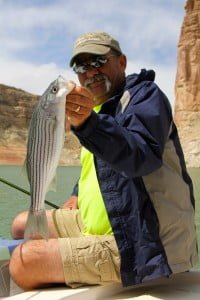Carl Lind, Peoria AZ, caught some nice fat stripers while trolling in the back of Last Chance Bay in Lake Powell. All fish species are heating up and becoming more catchable with the warm weather. The quality of fish caught this spring is unsurpassed
Lake Powell Fish Report – April 7, 2015
Lake Elevation: 3590
Water Temperature 56 – 62 F
By Wayne Words
The unseasonably warm water experienced during the past week has now turned seasonably cooler. The cold front chased bass off their nests, sent stripers deeper and slowed fishing success temporarily. But it reality that makes this a normal April with the various changes that occur every Spring. Now it is easy to predict what will happen next by looking at the temperature and weather forecast. Plan the fishing trip for 3-5 day warming periods and avoid cold fronts if possible.
Both large and smallmouth bass made nests and some spawning probably occurred. But as water cools bass leave the beds and wait for the next warming period when the nests can then be freshened up and more eggs laid. During a normal spring male bass will guard 4-6 different batches of eggs and fry.
Weather is predicted to warm up this weekend. Expect bass to return to shallow rocky structure when surface water temperature exceeds 62F in the morning period. The next spawn will include many more fish than the few that made nests during the first week of April. Bass fishing success will also increase. One major change is that bass fishing success will be much better in clear water. Bass can now be caught on virtually all rocky habitat over the length of the lake.
Walleye will get more active with the next water warm up. The key to catching walleye is to fish low light periods in morning and evenings with slowly worked plastic baits that creep along the bottom in 12-25 feet of water. Another friend of walleye anglers is wind and wave action that ruffles the water surface and reduces visibility allowing walleye to see bait and lures more clearly through their light sensitive eyes. Walleye numbers are much higher from Bullfrog to the Colorado River inlet near Trachyte Canyon. Runoff water makes the water murky which also enhances walleye success.
Striped bass moved from shallow warm water back to deep water with the recent cooling period. In the past few days the best success for larger stripers was found by those trolling deep diving lures in the 20-45 foot strata. Adult and juvenile stripers are divided by size. Smaller fish are near the surface where plankton is found. Young stripers can feed on these random open water congregations of tiny microscopic animals and maintain good condition by the food obtained. But all stripers are habitually required by nature to consume any fish or lure that invades their personal space. A shallow running lure that zips through the feeding school will be whacked. While trolling lipless vibrators recently we often feel many little ticks before hooking a striper. My guess is that the trolled lure runs through a school of plankton eating stripers that just nibble at the lure before one finally opens its mouth enough to take the hook. When nibblers are contacted mark the spot and return to cast lures to the location for a quick catch of stripers.
It was recently reported that stripers were seen in the famous Buoy 25 coves that were so good two years ago. We investigated and found that to be true. Many nibblers were found with respectable numbers caught while trolling LVs. The clear water makes it easy for stripers to just go deep to avoid boat traffic trolling overhead. I have predicted that bait fishing will be slow this spring but this spot may be the perfect place to find lots of success using anchovies. Striper numbers are large and the friendly deep water with shallow benches tend to hold stripers that come up to eat plankton and dive to avoid trouble. It would be worthwhile to try bait at Buoy 25 just like the good old days




